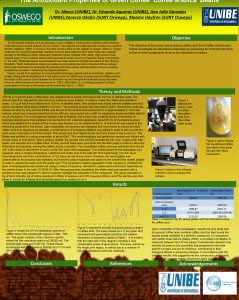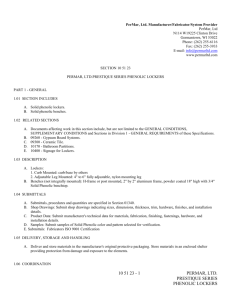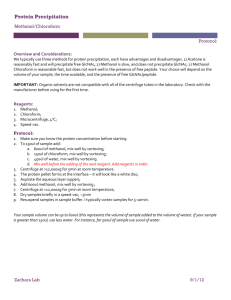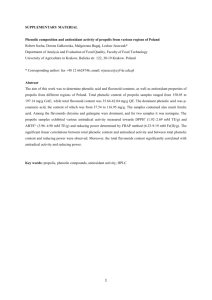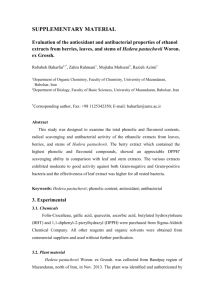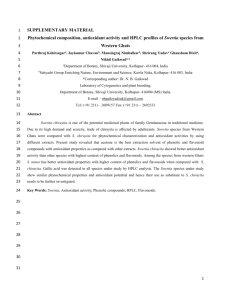Comparison of phenolic content and antioxidant activity of
advertisement
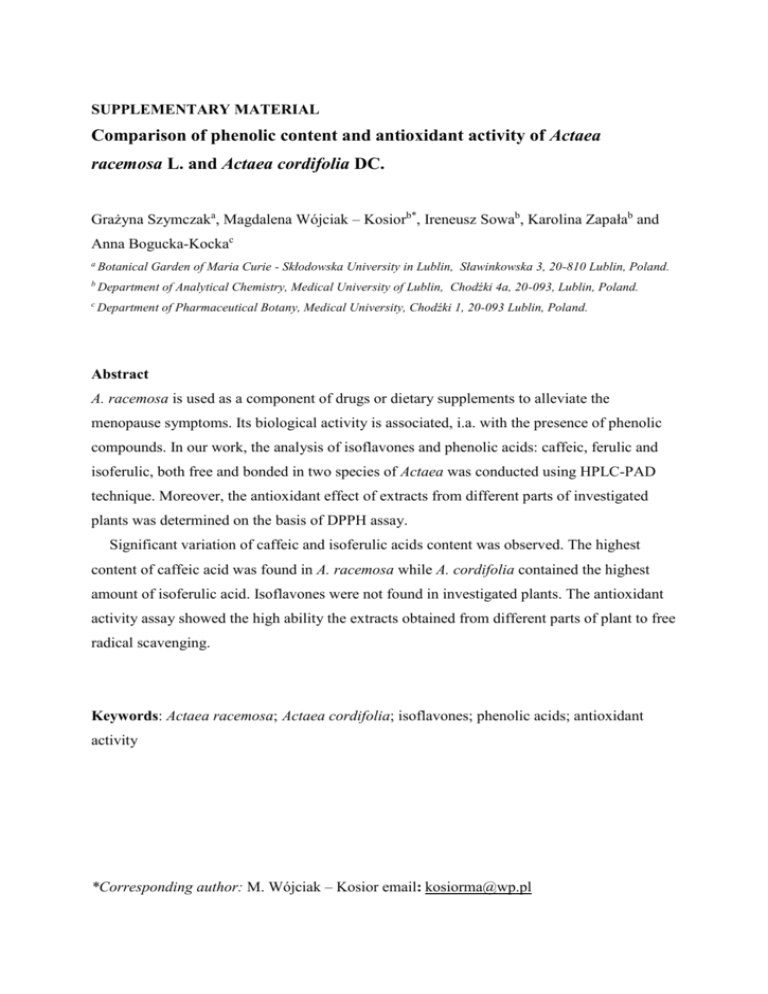
SUPPLEMENTARY MATERIAL Comparison of phenolic content and antioxidant activity of Actaea racemosa L. and Actaea cordifolia DC. Grażyna Szymczaka, Magdalena Wójciak – Kosiorb*, Ireneusz Sowab, Karolina Zapałab and Anna Bogucka-Kockac a Botanical Garden of Maria Curie - Skłodowska University in Lublin, Sławinkowska 3, 20-810 Lublin, Poland. b Department of Analytical Chemistry, Medical University of Lublin, Chodźki 4a, 20-093, Lublin, Poland. c Department of Pharmaceutical Botany, Medical University, Chodźki 1, 20-093 Lublin, Poland. Abstract A. racemosa is used as a component of drugs or dietary supplements to alleviate the menopause symptoms. Its biological activity is associated, i.a. with the presence of phenolic compounds. In our work, the analysis of isoflavones and phenolic acids: caffeic, ferulic and isoferulic, both free and bonded in two species of Actaea was conducted using HPLC-PAD technique. Moreover, the antioxidant effect of extracts from different parts of investigated plants was determined on the basis of DPPH assay. Significant variation of caffeic and isoferulic acids content was observed. The highest content of caffeic acid was found in A. racemosa while A. cordifolia contained the highest amount of isoferulic acid. Isoflavones were not found in investigated plants. The antioxidant activity assay showed the high ability the extracts obtained from different parts of plant to free radical scavenging. Keywords: Actaea racemosa; Actaea cordifolia; isoflavones; phenolic acids; antioxidant activity *Corresponding author: M. Wójciak – Kosior email: kosiorma@wp.pl 3. Experimental 3.1 Plant material Two species: A. racemosa L. and A. cordifolia DC. were collected during autumn season in 2013 year in Botanical Garden of UMCS in Lublin, identified in Department of Pharmaceutical Botany Medical University of Lublin and deposited in Botanical Garden of UMCS (voucher specimen number: 2299 and 3275, respectively). The plants were divided on roots (R1, R2), rhizomes (Rh1, Rh2) and shoots (S1, S2), dried at 40°C and pulverized. 3.2 Chemicals and reagents Methanol, HPLC-grade acetonitrile and trifluoroacetic acid (TFA) were purchased from Merck (Darmstadt, Germany). Water for HPLC was purified by ULTRAPURE Milipore Direct-Q® 3UV–R (Merck, Darmstadt, Germany). Standards: caffeic (CA), ferulic (FA), isoferulic acids (iFA), daidzein (D), genistein (G), formononetin (F), biochanin A (BA), trolox and 1, 1-diphenyl-2-picryl-hydrazyl (DPPH) were from Sigma-Aldrich (St. Louis, MO, USA). 3.3 Extraction and Standard Preparation 1 g of plant material was accurately weighed and extracted with 20 mL of methanol in ultrasonic bath during15 min. The procedure was repeated three times with a fresh portion of solvent. The combined extracts were concentrated to 10 mL. Phenolic acid standards: 1.5 mg of caffeic and ferulic acid, and 5 mg of isoferulic acid were dissolved in 25 mL of methanol (final concentration was 60 µg mL-1 and 200 µg mL-1, respectively). Standard solutions were prepared by dilution of stock solutions in methanol to appropriate concentrations. 3.4 HPLC condition Chromatographic determination was performed on VWR Hitachi Chromaster 600 chromatograph (Merck, Darmstadt, Germany) with pump (5160), an degasser, thermostat (5310), autosampler (5260), DAD detector (5430) and EZChrom Elite software. The extracts were analysed on C18 reversed-phase column LiChrospher 100 (Merck) (25 cm × 4.0 mm i.d., 5 μm particle size), at temperature of 25°C. Twenty µL (R1,R2, Rh1 and Rh2) or forty µL (S1 and S2) of sample was injected. Mixture of acetonitrile (solvent A) and water with 0.025% of trifluoroacetic acid (solvent B) was used as a mobile phase. Phenolic acids were separated by gradient elution: A 10%, B 90% during 0-15 min, and next A 15%, B 85 % during 15.5-35 min. The gradient elution program for isoflavones analysis was as follow: A 30%, B 70% during 0-10 min, A increased 30-50% during 15.5-35 min. The flow rate of eluent was 1.0 mL min-1. The data were collected in the range of wavelength from 200 to 400 nm. The quantitative analysis of phenolic acids were performed at λ=320 nm. 3.5 DPPH test Methodology of DPPH assay was established on the basis of literature (Paduch et al., 2007; Tirillini et al., 2013). 10 µL of the extract sample was diluted with methanol up to 1 mL and 1 mL of DPPH solution at concentration of 0.1 mg mL-1 was added. After 30 minutes, the absorbance was measured at 515 nm. The percentage of inhibition activity was calculated from equation: [(A0-A1)/A0] x 100, where A0 is absorbance of control and A1 is absorbance of the extract. Trolox was used as a positive control. References Paduch, R., Wójciak-Kosior, M., & Matysik, G. (2007). Investigation of biological activity of Lamii albi flos extracts. Journal of Ethnopharmacology 110, 69-75. Tirillini, B., Menghini, L., Leporini, L., Scanu, N., Marino, S. & Pintore G. (2013). Antioxidant activity of methanol extract of Helichrysum foetidum Moench. Natural Product Research. 27, 1484-1487. Figure S1. The chromatographic analysis of isoflavones: 1- mixture of standards: daidzein (D), genistein (G), formononetin (F) and biochanin A (BA); Rh1 - extract from rhizome, R1extract from root and S1 – extract from shoot of A. racemosa. Figure S2. The chromatographic analysis of phenolic acids: 1- mixture of standards: caffeic acid (CA), ferulic acid (FA), isoferulic acid (iFA), Rh1 - extract from rhizome, R1- extract from root and S1 – extract from shoot of A. racemosa. Figure S3. The content of caffeic (CA), ferulic (FA) and isoferulic acid (iFA) in root (R), rhizome (Rh) and shoot (S) in A. racemosa (1) and A. cordifolia (2) unbundled after acidic hydrolysis.

